

| These two colossal statues (about 20 meters high) of the deified Amenophis III once flanked the entrance of the first pylon at the pharaoh's mortuary temple. The temple is now completely destroyed, ruined first by flood waters and later cannibalized for its stone. Both statues are damaged as well, lacking their faces and tall royal crowns. | ||
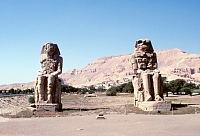
|
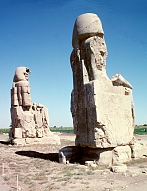
|
These colossal statues illustrate the gigantism of much of Egyptian art. See also the colossal statue of Ramses in the Memphis Museum and the statues at the entrance of the Temple of Luxor. |
The left (or Southern colossus)This statue has Amenophis' wife, Queen Tiy, and mother (Mutememuia) on opposite sides of the base. |
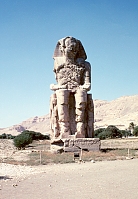
|
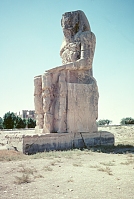
|
Details of the base of the left (South) ColossusThe thrones of both statues depict two Nile gods winding the papyrus and lotus, symbols of Lower and Upper Egypt, around the hieroglyph for "unite." This is a common motif; see, for example, the thrones for the figures at the Temple of Ramses at Abu Simbel. | ||
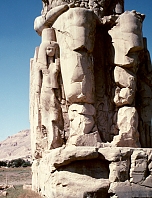
|
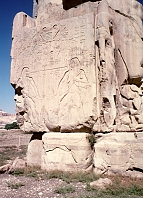
|
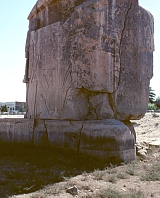 |
| Technically only the right (northern) statue should be called the colossus of Memnon. After an earthquake damaged it, this statue emitted strange sounds in the morning, perhaps due to the heat of the sun, or the humidity of the night. "The ancient Greeks looked for an explanation in the legendary story by Homer about Memnon, the son of Eos (Aurora) and Titon, who was killed by Achilles and reappeared in Thebes as a statue, and every morning lamented at the sight of his mother rising in the skies" (Siliotti 122). | ||
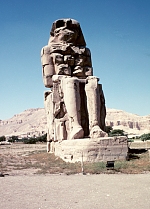
|

|
The right (northern) statueThis statue was repaired in 199 CE; it sang no more. |
Details of the right (north) statue | 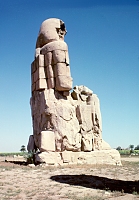
|
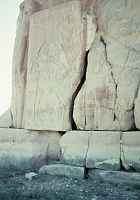
|
 Click here to go to the Egypt Index.
Click here to go to the Egypt Index.
 Click here to return to index of art historical sites.
Click here to return to index of art historical sites.
 Click here to return to index of artists and architects.
Click here to return to index of artists and architects.
 Click here to return to chronological index.
Click here to return to chronological index.
 Click here to see the home page of Bluffton College.
Click here to see the home page of Bluffton College.
